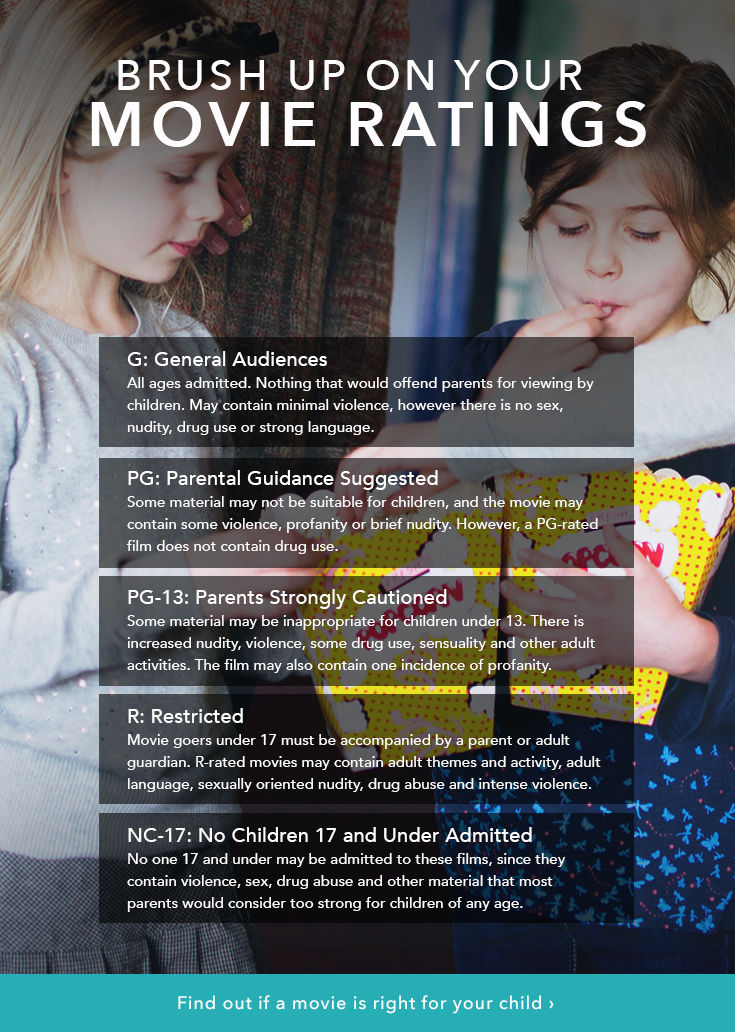Unlike your childhood, your kids can now access movies on TV, tablets, computers — even your phone! It can be difficult to manage all the entertainment that your children consume, but understanding movie ratings for kids can help you judge whether or not content will be appropriate for your child.
Understand the Rating System
The most common film rating system was established by the Motion Picture Association of America (MPAA) and is based on the amount of violence, language, substance abuse, nudity and sexual content. Ratings include:
- G: General Audiences
All ages admitted. Nothing that would offend parents for viewing by children. May contain minimal violence, however there is no sex, nudity, drug use or strong language.
- PG: Parental Guidance Suggested
Some material may not be suitable for children, and the movie may contain some violence, profanity or brief nudity. However, a PG-rated film does not contain drug use.
- PG-13: Parents Strongly Cautioned
Some material may be inappropriate for children under 13. There is increased nudity, violence, some drug use, sensuality and other adult activities. The film may also contain one incidence of profanity.
- R: Restricted
Movie goers under 17 must be accompanied by a parent or adult guardian. R-rated movies may contain adult themes and activity, adult language, sexually oriented nudity, drug abuse and intense violence.
- NC-17: No Children 17 and Under Admitted
No one 17 and under may be admitted to these films, since they contain violence, sex, drug abuse and other material that most parents would consider too strong for children of any age.

These movie ratings are intended to serve as a guide for parents when determining whether or not a film is appropriate for their child. Denise Lisi DeRosa, a program manager at the Family Online Safety Institute (whose Good Digital Parenting Initiative aims to educate parents on digital safety), explains that parents should “know about your child and what he or she can handle.
Accompanying the rating is a description of the reason for that determination: strong violence, sexual content, nudity, crude humor, etc. One family may feel strongly about one determining factor but not particularly concerned about another.” Look at the reasons the film was given its rating and decide if it’s something you’re OK with your child seeing.
Know Your Children
You should also consider the entertainment that your children have reacted to positively in the past. Are they fans of sci-fi, fairy tales and magic? If they have demonstrated an interest in a particular genre and have viewed similar films in the past, they are more likely to be prepared for the moments that have contributed to the movie’s rating.
If your child was upset in the past by scary scenes in a similar movie, you may want to reconsider the frightening moments that may be listed in a movie’s PG rating — or else you may find yourself triple-checking under the bed for monsters at bedtime.
The reasons for a film’s rating will accompany the earned rating and help parents to decide if would be appropriate viewing or not for their child.
Other questions to ask when determining if a movie is appropriate for your child may be:
- Will your little one understand the content, or will she question what they have viewed?
Have conversations before and after watching movies with challenging or unfamiliar ideas.
- What are the issues that most concern you in a film?
Think about things your child may struggle with specifically. If you know your little one is going through a copycat phase, you may want to pay close attention to the “strong language” listed in a movie’s rating.
Know Where Else to Look
If movie ratings leave you asking more questions about a movie’s content, do your own homework. Jon Murchinson, the vice president of communications for children’s media site Common Sense Media, says that, “Parents should view movie trailers, refer to detailed third-party reviews and ratings — such as provided at Common Sense Media — and speak with other parents in order to ensure that they are informed about the movies their kids are watching.”
If you’re not sure what the film is like, do some digging before purchasing tickets. Check out sites like Fandango’s Family Guide, Kids in Mind, Common Sense Media and Rotten Tomatoes, which can help you learn more about what’s included in the film and what other parents thought of the content.
Having a good understanding of your child’s likes and dislikes can make using movie ratings for kids a simple process and decision. When used appropriately, movie ratings for kids can ensure your children are safely entertained and encouraged to think creatively about new people, places and things.
And check out Should You Use Parental Controls?
Jennifer worked as a teacher as well as in press and legislation on Capitol Hill. She now chronicles motherhood and pop culture on her blog, Mom Tattles.






